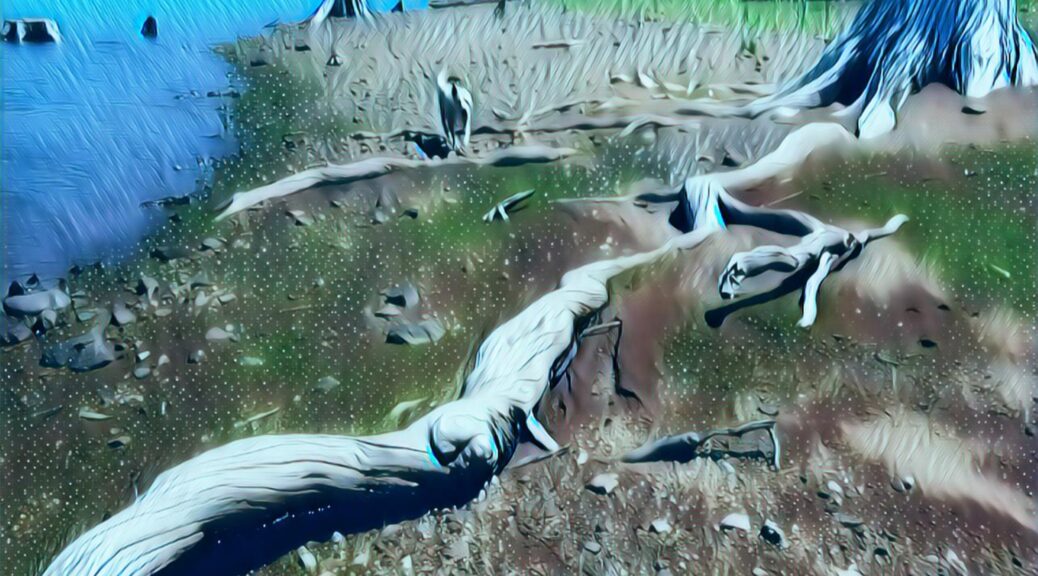In 2014, my biologist brother, Andy, sent me a speech by mushroom specialist Paul Stamets. Initially, I doubted. But by the end of the speech I was in tears of relief. Stamets showed us how fungus had cleaned up a diesel spill, as well as a chemical waste, restored ecosystems, and performed pest control. We were not alone, nor were we dependent on humankind. There was a resilient being protecting and healing Earth.
Thereafter, Andy and I joked about praying to The Great Mycelium. We hoped it would never consider us pests.
Still, Stamets warned, “we need to have a paradigm shift in our consciousness. If we don’t get our act together and come in commonality and understanding with the organisms that sustain us today, not only will we destroy those organisms, but we will destroy ourselves.”
What we lacked was consciousness of our kinship with all living beings and Earth.
In the early 1990s a close-knit group of geniuses, the Synergists, built and tested the first biosphere in the desert of Arizona. It was to be the first of many, designed with the goal of collecting data and of troubleshooting—so that one day they could create a spaceship or an extra-terrestrial colony on which to preserve life from Earth.
They traveled the globe collecting species for their mini jungle and their mini ocean, their mini forest and their mini meadow. “Do you know how many flowers it takes to feed a hummingbird?” one asked. They made a mystical home, wherein they knew every living being and felt their interconnectedness with all life.
But when they tried to to live off that land, they suffocated and starved. They went insane on carbon dioxide poisoning, fighting and spinning conspiracy theories against one another. The animals suffered needlessly. In the end, the Synergists had to bring in oxygen from outside in order to survive the full two years of their experiment.
I also heard that, without wind to make them strong, the trees fell over.
The SIA had learned two things from the Synergists. One, maintain secrecy. Two, work with the Great Mycelium.
It is now well known that the vegetative part of a fungus, consisting of a network of fine white filaments, called the mycelia, link into root systems of trees, plants, and other mycelial webs and transfer information and nutrition.
Perhaps the Synergists had cut their world off from this, the source of life beneath.

The intelligence of plants, laughed off by some scientists until recently, grew from the complex mind of the mycelium, which, as Stamets pointed out, grows like neurons or the nerve cells in our minds, like the dark matter of space, and like the network of the internet.
According to the research of Suzanne Simard, a forest ecologist at the University of British Columbia, “trees in a forest organize themselves into far-flung networks” and use the mycelium, which “connects their roots to exchange information and even goods.” Trees communicate, “convey warnings of insect attacks, and also to deliver carbon, nitrogen, and water to trees in need.”
Says Stamets, the “mycelium is the neurological network of nature. Interlacing mosaics of mycelium infuse habitats with information-sharing membranes. These membranes are aware, react to change, and collectively have the long-term health of the host environment in mind. The mycelium stays in constant molecular communication with its environment, devising diverse enzymatic and chemical responses to complex challenges.”
Sagebrush warns its fellows of a pest intrusion.
In a 2013 article, “The Intelligent Plant,” New Yorker contributer, Michael Pollan imagined the scent of sage as an “invisible chemical chatter, including the calls of distress, going on all around.” He described the air as “powerfully aromatic, with a scent closer to aftershave than to perfume.”[‡]
A forest will even work across species to share food.
According to Simard, “fir trees were using the fungal web to trade nutrients with paper-bark birch trees over the course of the season. The evergreen species will tide over the deciduous one when it has sugars to spare, and then call in the debt later in the season. For the forest community, the value of this coöperative underground economy appears to be better over-all health, more total photosynthesis, and greater resilience in the face of disturbance.”
Western scientists were naïve to the knowledge of people 10,000 years ago or that of African, Asian, and Indigenous societies, who depended on fungi and the inventions of mycelium to preserve fire, as antibiotics, as anti-inflammatories. And much, much more.
While humans were transforming the planet with art and technology and war and pollution, the mycelium had also been at work, resolving the devastations of our time. Ask yourself what capacity the Great Mycelium has.
“Let your imagination go wild,” answers Stamets.
With the leadership of Indigenous scientists who were also members, the SIA and the golden women had learned to work with the mycelium, to communicate a vision with the intelligence of slime molds and polypores.
The mycelium tech in my mask (and in the recycling centers we delivered garbage to and in the ones that were soon propagated on satellites twinkling in our night skies from 2025-2040) was based in this and other Traditional Ecological Knowledges kept by friends and members of SIA and put to multiple purposes by the Arks and Islands of the Multiversity.
We were remembering.
And there would be so much more to learn from fungus—about time travel for example.

